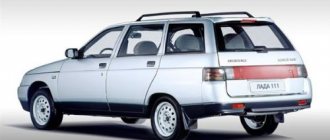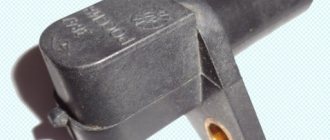Rated fuel consumption is one of the most informative and important characteristics of a car for the driver. This is what manufacturers often use to advertise and promote a particular new car model.
Among owners of used cars, it is considered acceptable to consume up to 10 liters of gasoline or diesel per 100 kilometers. In foreign countries, this indicator is indicated in miles, so recalculation into “native” units is often necessary. The fuel consumption tables available in this section of the site are considered very useful.
What does the fuel consumption indicator indicate? What does this characteristic mean? We are talking about hydrocarbon fuel consumption. For example, for an SUV the figure corresponds to 9.5 liters per 100 km. It is quite acceptable, primarily due to the weight and power of the car. The indicator can be reduced due to the following:
- use of energy recovery systems during braking;
- lightening the weight of the car when replacing body and chassis elements with innovative materials;
- engine improvements;
- replacing the exhaust system.
For new models, consumption of 6 l/100 km is considered quite a “cruising” figure, but it will be higher for heavy SUVs and pickups and lower for small hybrids. The necessary information can be found in the tables provided.
What to do if fuel consumption is higher than rated? If the car consumes more fuel and does not correspond to the nominal value indicated in the table, this means there is a malfunction. Experienced service center technicians will tell you how serious it is and how it can be eliminated. In some cases, tuning makes it possible to further optimize fuel consumption, but this is usually achieved by lightening the body structure or by replacing the engine. Professional automotive technicians can provide specific recommendations.
Fuel consumption of the Lada Granta ranges from 6.5 to 7.7 liters per 100 km.
Lada Granta is available with the following types of fuel: Gasoline AI-95.
Fuel consumption Lada Granta restyling 2022, station wagon, 1st generation
| Engine capacity | Power | Transmission | Drive unit | Fuel | Consumption |
| 1.6 l | 106 hp | robot | front-wheel drive | Gasoline AI-95 | 6,5 |
| 1.6 l | 106 hp | Manual transmission | front-wheel drive | Gasoline AI-95 | 6,5 |
| 1.6 l | 87 hp | Manual transmission | front-wheel drive | Gasoline AI-95 | 6,8 |
| 1.6 l | 98 hp | Automatic transmission | front-wheel drive | Gasoline AI-95 | 7,2 |
The world's main methods for measuring the consumption of new cars
As we wrote above, there are several methods for measuring the average fuel consumption of cars. Let's tell you more about them.
NEDC
In Europe, the most commonly used cycle is the NEDC type, which was developed about forty years ago. This causes reproaches from experts who talk about the outdatedness of the method.
NEDC Algorithm Structure
The main features can be considered that manufacturers are allowed to use a selective method for selecting a machine. We are talking about the fact that for testing we provide cars with already run-in components, special lubricants of low viscosity, as well as with the most compact tires that can be installed on a car.
In addition, if desired, testing can be carried out with the radio, heating, and so on turned off. This allows you to “select” those results that would best suit the manufacturer.
Measurements are carried out in the urban (NEDC UDC) and suburban (NEDC EUDC) cycles. The length of the "urban test" is 780 seconds, while the suburban test involves a period of time equal to 400 seconds. In the first case, the average speed will be a little over 18 kilometers, and in the second - about 62.6 kilometers per hour.
This technique is criticized for the reason that many models with an additional electric motor can travel most of this short distance without using the internal combustion engine. This becomes the source of amazing results with extremely low fuel consumption, even in sports cars.
FTP-75
But these standards no longer meet market requirements, so manufacturers are increasingly turning to the American standard FTP-75. It is considered the closest to reality, although experts talk about problems with the lack of areas where movement occurs evenly.
FTP-75 algorithm speed dependence
It is similar to the European NEDC, including an average speed of 34.1 kilometers per hour. Another advantage is that the test duration is 1874 seconds, so it is more difficult for hybrid car models to show “unrealistically low” fuel consumption figures. But what is most important is that the American version of the test obliges manufacturers to include air conditioning if it is included in the package.
As a result, fuel consumption in this test is higher than in NEDC by 10 or even 20 percent.
Japanese cycle JC08
In the case of JC08 the difference will be even greater. The fact is that in it the number of accelerations and decelerations is maximum, and there are no long sections with even speed parameters at all.
In addition, the maximum speed does not exceed 80 kilometers per hour. On one of the sections, the length of which is 8.2 kilometers, the average speed does not even reach 25 kilometers per hour.
The slowest known method for calculating average flow
Of course, we can talk about the severity of the test, but it takes into account the increased load on the streets, which is typical for the island country of Japan. In addition, drivers in most large cities around the world find themselves in such conditions. So, it is worth considering this technique as the closest to reality.
In general, there is no optimal testing method yet. The current options represent a compromise that automakers are trying to use to their advantage. Therefore, you should always try to take into account the specific technique that gave the results specified in the vehicle specifications.
Fuel consumption Lada Granta restyling 2022, liftback, 1st generation
| Engine capacity | Power | Transmission | Drive unit | Fuel | Consumption |
| 1.6 l | 106 hp | robot | front-wheel drive | Gasoline AI-95 | 6,5 |
| 1.6 l | 106 hp | Manual transmission | front-wheel drive | Gasoline AI-95 | 6,5 |
| 1.6 l | 87 hp | Manual transmission | front-wheel drive | Gasoline AI-95 | 6,8 |
| 1.6 l | 98 hp | Automatic transmission | front-wheel drive | Gasoline AI-95 | 7,2 |
Owner reviews
“I initially didn’t really like the appearance of the new VAZ model, but when the liftback version appeared, I seriously thought about buying it. After saving a little, I bought it. I can say that for a Russian car, everything here is not even bad. The interior is rather rustic, but there is a lot of stuff even in the basic version. Over several years of use there was not even a hint of anything breaking. Due to its small size, the car is well suited for city use. But I also enjoy driving on the highway. Here the VAZ engine performs well, allowing you to quickly gain the speed necessary for a comfortable ride. It's a pity that the car has high consumption. The version with automatic transmission consumes up to 12 liters in the city, and on the highway it reaches 8,” writes Grigory from Podolsk.
“When I was choosing a car, I paid attention to many parameters. The main one was fuel consumption. According to the reviews that I read a bunch, Granta’s was not great. And so, in 2014, I bought it. What’s attractive is that it was made with our roads in mind. Although the suspension is stiff, you don’t feel any bumps or potholes. But in the cabin everything is not so rosy. It itself is made so-so, it constantly sticks together and rattles, and the sound insulation suffers, which is why many sounds from the street can be heard. But the cost of gasoline really turned out to be minimal. My consumption rate is 8 liters, and in winter the consumption does not exceed 10 liters,” says Victor from Lipetsk.
And this is Ilya’s review from Tolyatti:
“I’ve always driven foreign cars, but after mine began to break down often, I started thinking about buying a new car. I noticed a new product from the domestic automobile industry - the Grant liftback. During the first year of driving I did not experience any problems at all. Everything was perfect both technically and comfort-wise. But recently the dashboard began to creak, and the sound insulation also became unusable. This is very annoying and does not allow you to relax on long trips. The solution to the problem is listening to music at medium volume. Otherwise, everything is good so far. I like the dynamic performance, and my wife is happy with the trunk, which can accommodate all her many purchases. In terms of consumption, I will say that it is acceptable and does not exceed 10 liters in the city.”
“The first thing I want to say after using the car for a year is that the car is ideal for our roads. It's set high, the suspension is stiff with decent travel, so you don't feel any potholes, of which we have a lot. Nothing has broken yet, the service was only to replace consumables. He looks great, always loved compact cars. The feel of the interior is a little worse; they clearly saved on the quality of the assembly and materials. But there is a lot of free space, which is good news. I drive mostly around the city and rarely go outside, so it takes a lot of fuel. The norm for me is 10 liters,” notes Vitaly from Omsk.
And this is how Philip from Rostov speaks about his choice:
“I don’t regret that I bought this particular car at the time, although there were many options. He has never let me down yet. Perfect for use both for city needs and for long trips. Good cross-country ability and unpretentiousness allow you to drive even where there are no roads at all. The engine pulls vigorously, speed and acceleration are quite enough. It consumes 1 liter of fuel in the city and 8 on the highway.”
“During the time that I have been using the car, I have realized that if you look after it and care for it properly, it will last for many years. So, in 3 years of driving, I have never visited a repair shop for serious reasons. I made all replacements of consumables in a timely manner. The only thing I don't like about it is the interior quality. At high speed it will rattle and rattle a lot. Otherwise, everything is fine and I’m definitely not going to change the car,” writes Stanislav from St. Petersburg.
The Lada Granta was released by AvtoVAZ in 2011. It replaced the Kalina model and the fuel consumption of the Lada Granta per 100 km is significantly different from its predecessor.
Fuel consumption Lada Granta restyling 2022, hatchback 5 doors, 1st generation
| Engine capacity | Power | Transmission | Drive unit | Fuel | Consumption |
| 1.6 l | 106 hp | robot | front-wheel drive | Gasoline AI-95 | 6,5 |
| 1.6 l | 106 hp | Manual transmission | front-wheel drive | Gasoline AI-95 | 6,5 |
| 1.6 l | 87 hp | Manual transmission | front-wheel drive | Gasoline AI-95 | 6,8 |
| 1.6 l | 98 hp | Automatic transmission | front-wheel drive | Gasoline AI-95 | 7,2 |
Seasonality
The most expensive car is in winter and summer. Moreover, it is more difficult precisely in the cold season, because in the heat the owner only needs to monitor the engine temperature and the operation of the air conditioner. In cold weather, other factors also influence consumption:
- winter tires;
- heating;
- heated mirrors and rear view glass;
- the need to drive as carefully as possible, etc.
In the modern world, where the price of fuel is constantly rising, it is necessary to think about how to save on your movement. Giving up the car is not an option, but trying to reduce fuel consumption, in particular on the Lada Granta, can be considered an acceptable option. This is exactly what we will talk about today.
Fuel consumption Lada Granta restyling 2022, sedan, 1st generation
| Engine capacity | Power | Transmission | Drive unit | Fuel | Consumption |
| 1.6 l | 106 hp | robot | front-wheel drive | Gasoline AI-95 | 6,5 |
| 1.6 l | 106 hp | Manual transmission | front-wheel drive | Gasoline AI-95 | 6,5 |
| 1.6 l | 87 hp | Manual transmission | front-wheel drive | Gasoline AI-95 | 6,8 |
| 1.6 l | 98 hp | Automatic transmission | front-wheel drive | Gasoline AI-95 | 7,2 |
Factors influencing the flow rate
The question of what fuel consumption has no semantic basis, since it does not take into account a number of important aspects:
- level of factory equipment;
- driving style;
- the presence of additionally installed elements (discs with an increased radius, a bulky rear wing and other body kit, etc.).
It is realistic to identify at least six reasons, under the influence of which fuel consumption per 100 km can “soar” to an unprecedented 20-21 liters. Such figures, especially for a budget car, have a shocking effect on any owner of a Lada Grant.
The factors considered include the following.
Fuel consumption Lada Granta 2013, liftback, 1st generation
| Engine capacity | Power | Transmission | Drive unit | Fuel | Consumption |
| 1.6 l | 106 hp | robot | front-wheel drive | Gasoline AI-95 | 6,5 |
| 1.6 l | 106 hp | Manual transmission | front-wheel drive | Gasoline AI-95 | 6,5 |
| 1.6 l | 87 hp | Manual transmission | front-wheel drive | Gasoline AI-95 | 6,6 |
| 1.6 l | 106 hp | robot | front-wheel drive | Gasoline AI-95 | 6,6 |
| 1.6 l | 106 hp | Manual transmission | front-wheel drive | Gasoline AI-95 | 6,7 |
| 1.6 l | 87 hp | Manual transmission | front-wheel drive | Gasoline AI-95 | 7,0 |
| 1.6 l | 98 hp | Automatic transmission | front-wheel drive | Gasoline AI-95 | 7,2 |
| 1.6 l | 98 hp | Automatic transmission | front-wheel drive | Gasoline AI-95 | 7,6 |
Video about fuel economy
Content
Lada Granta is a direct descendant of Lada Kalina; production of this model began in mid-2011, and first sales started in December of the same year. Budget front-wheel drive sedans and liftbacks are representatives of the C-class. A station wagon is planned for release in 2016. Assembly takes place at Russian car factories and in Kazakhstan. A variation of the Lada Granta Sport model takes part in racing competitions. Production continues to this day.
Fuel consumption Lada Granta 2011, sedan, 1st generation
| Engine capacity | Power | Transmission | Drive unit | Fuel | Consumption |
| 1.6 l | 106 hp | robot | front-wheel drive | Gasoline AI-95 | 6,5 |
| 1.6 l | 106 hp | Manual transmission | front-wheel drive | Gasoline AI-95 | 6,5 |
| 1.6 l | 87 hp | Manual transmission | front-wheel drive | Gasoline AI-95 | 6,6 |
| 1.6 l | 106 hp | robot | front-wheel drive | Gasoline AI-95 | 6,6 |
| 1.6 l | 106 hp | Manual transmission | front-wheel drive | Gasoline AI-95 | 6,7 |
| 1.6 l | 98 hp | Manual transmission | front-wheel drive | Gasoline AI-95 | 6,8 |
| 1.6 l | 87 hp | Manual transmission | front-wheel drive | Gasoline AI-95 | 7,0 |
| 1.6 l | 98 hp | Automatic transmission | front-wheel drive | Gasoline AI-95 | 7,2 |
| 1.6 l | 82 hp | Manual transmission | front-wheel drive | Gasoline AI-95 | 7,4 |
| 1.6 l | 98 hp | Automatic transmission | front-wheel drive | Gasoline AI-95 | 7,6 |
| 1.6 l | 87 hp | Automatic transmission | front-wheel drive | Gasoline AI-95 | 7,7 |
How to find out the consumption yourself
The method described here allows you to determine as accurately as possible for your specific case the amount of fuel burned per 100 kilometers.
The procedure is as follows:
- Having used up the fuel as completely as possible, fill the tank to capacity, that is, until the dispenser pistol fires the first “shot”;
- the daily mileage scale is set to zero;
- after one day, compare the distance covered by the car with fuel consumption.
For example, if you drove a conventional 400 kilometers and consumed 31 liters of fuel, then dividing the amount of liters by the first number and multiplying the result by 100, we get 7.75, which is the real value for you.
By acting in this way, you will know exactly what the exploitation of Grants will cost you.
In principle, the Granta’s power plant belongs to the small-displacement category. Such vehicles in general are not capable of consuming a lot of fuel. However, there are many factors that directly influence this indicator. We will talk about them in more detail below.











